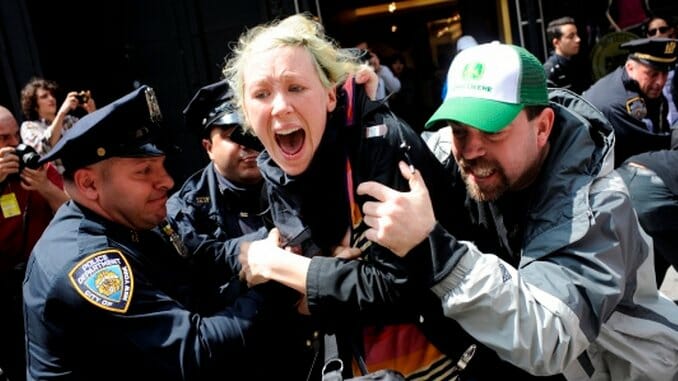
99%: The Occupy Wall Street Collaborative Film chronicles political protests that were largely known for not having a clear, cohesive voice. That the documentary also struggles to find a focal point seems so expected it’s almost not worth reporting. Alternating between fascinating and routine, this ambitious movie attempts to track the Occupy Wall Street demonstrations that began in September 2011 in the heart of New York City’s financial district, and tapped into a nation’s—and world’s— anger.
As implied in the laborious title, the documentary is credited to more than 100 filmmakers who contributed footage from the various offspring of the Occupy movement, including both coasts of the United States, the heartland in between and more spots around the world. While its crowd-sourced production might lead you to expect some wild experimentation, the documentary feels fairly conventional. The structure may be tangental and unshapely, but the making of this movie was definitely more authoritative than an Occupy meeting, with “founding directors” Audrey Ewell and Aaron Aites responsible for the final product. Time and money clearly went into both the technical and stylistic aspects of making the different video sources mesh. The principal directors and editors massaged the footage into a disciplined 97 minutes and put it in simple context. Archival news clips set the stage. Talking heads—like Matt Taibbi of Rolling Stone—explain the issues while the movie weaves through different subjects, some fleeting and some recurring.
To establish the anger that fueled the protests, 99% whizzes through topics that either could or do have entire documentaries devoted to them, including wage disparity, the war in Iraq, the mortgage crisis and mega-corporations’ control over politics. It then moves to the zeitgeist’s emergence as its members attempt to establish and manage a fast-growing movement without the defined voice of a single leader or a media-friendly soundbite.
The movie fails to make a convincing argument that Occupy Wall Street affected any major policy changes, but it does provide interesting insight into police brutality, mass communication in the era of social media and the difficulty of managing a huge movement that doesn’t believe in leadership structures. The footage shot in the trenches is the real selling point. It gives a feel for what it was like occupying public spaces. Webcam and cell phone footage calls attention to the new-era grassroots tools that were used to spread the word and make the movement as big as it became.
There’s a clear effort to highlight people who don’t fit the Occupy stereotype of young, jobless hippies. A middle-aged woman talks about how the mortgage crisis upturned her life. A retired, decorated police captain from Philadelphia insists on being arrested with his fellow protesters in New York. In Oakland, a flash grenade injures a veteran who served in Iraq.
The diversity also helps explains why Occupy didn’t have a single message: There were so many different types of people angry about the state of their country. Occupy Oakland is sort of seen as the trouble-making bad boy of the demonstrations, and blamed for violence encroaching on the peaceful philosophy. But as one of its members says, they have their own perspective and their own voice. They aren’t representing a fixed agenda; they’re representing themselves.
When the movie premiered at Sundance, the promoters and filmmakers billed it as an unbiased, propaganda-free chronicle of Occupy Wall Street and its spawn. The film’s structure and contributors, however, prevent that from being the case. Outside of a few hollow clips from cable news, no one really challenges the demonstrations’ premise. The loudest dissenting voice comes from Naomi Wolf, who questions Occupy’s messaging and alleged accomplishments rather than its worldview. There isn’t anything wrong with this slant, especially given that big media rarely provided an in-depth examination of Occupy Wall Street, but it’s disingenuous to claim that the film isn’t cheerleading.
Perhaps 99% would have had a greater impact if opposing voices had been heard and countered, coaxing Occupy’s proponents to strengthen their arguments. Or maybe the movie should have emphasized the need for more regrouping and less patting of oneself on the back. What it does achieve is an overview of Occupy Wall Street as it existed for a busy, tumultuous while. It’s not definitive, tidy or entirely cohesive, but hey, neither was the movement.
Founding Directors: Aaron Aites, Audrey Ewell & others
Featuring: Matt Taibbi, Naomi Wolf, Richard Wilkinson, Micah White, Hero Vincent
Release Date: Sept. 6, 2013